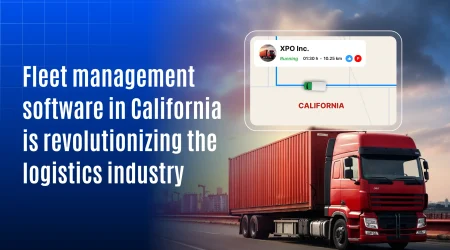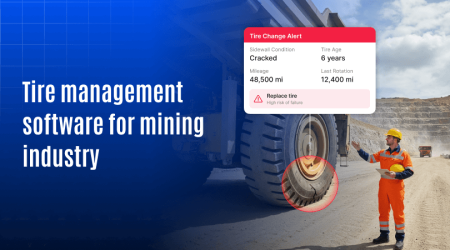Fleet GPS tracking in Illinois: How telematics helps manage regional distribution routes
Illinois stands as a major freight and logistics hub in the Midwest. With Chicago ranked among the top five U.S. cities for freight volume and over 1.2 billion tons of freight moving through the state annually, fleet operators face mounting pressure to stay efficient, compliant, and on time. The state’s highways, including I-55, I-80, and I-90, form the backbone of regional and national distribution. But rising fuel costs, urban congestion, and unpredictable delivery windows continue to affect fleet performance. That’s where GPS tracking and telematics come in: helping Illinois-based fleets monitor vehicle activity, plan better routes, and keep distribution flowing across both city streets and cross-state corridors.
Challenges in managing regional distribution routes in Illinois
Running fleet operations across Illinois is not just about moving goods; it’s about navigating complex routes, tight delivery windows, and highly variable driving conditions. Here are some of the key challenges fleet operators face in the region:
Urban congestion in and around Chicago
Deliveries entering or exiting Chicago regularly face delays due to traffic bottlenecks on I-90, I-290, and local access roads. Congestion increases idle time, fuel use, and schedule inconsistencies.
Unpredictable warehouse and rail yard turnaround times
Illinois serves as a national intermodal hub, especially around Joliet and Cicero. Without live tracking, fleets struggle to coordinate arrival times, leading to extended wait times at loading docks and yards.
Missed or delayed deliveries on cross-country routes
Distribution routes spanning cities like Rockford, Peoria, and Springfield require tight scheduling. Unmonitored driver activity and route deviations can result in late deliveries or increased operational costs.
Limited visibility over vehicle movement and delivery status
Operators managing fleets remotely often lack real-time updates on where vehicles are, how long they stop, or when delays occur—making proactive communication with clients difficult.
Inefficient fuel use across mixed driving conditions
From open stretches on I-57 to stop-and-go urban driving in Aurora or Naperville, fluctuating driving patterns make fuel optimization a constant challenge.
How GPS tracking and telematics streamline distribution in Illinois
Fleet management software with built-in GPS tracking and telematics tools provides end-to-end control over vehicles, routes, and delivery performance. Here’s how it addresses key challenges in Illinois-based operations:
Live tracking across urban and interstate routes
Real-time GPS updates help dispatchers monitor vehicle movement across congested areas like I-290 or the I-80 corridor. This visibility allows for quicker rerouting and better ETA management, especially in Chicago’s high-traffic zones.
Geofence alerts around warehouses and rail hubs
Fleet managers can set virtual zones around key facilities in places like Joliet or Bedford Park. Automated alerts help coordinate arrival times and reduce idle periods at loading bays, improving vehicle turnaround.
Route playback and deviation monitoring
The system tracks each delivery route in detail, capturing stops, detours, and travel times. This helps address delivery disputes, ensures driver accountability, and supports route improvements for Peoria, Springfield, and other mid-state hubs.
Driver behavior tracking and idle time control
Telematics tools monitor idling, speeding, harsh braking, and unauthorized stops. Fleet operators can train drivers to follow safer, more efficient driving patterns. Especially, it is important in fuel-variable conditions like stop-and-go traffic in Aurora.
Fuel analytics for mixed driving conditions
The platform provides fuel usage trends based on routes, driving habits, and terrain. Managers can identify which vehicles or routes are consuming more fuel and optimize accordingly for both urban and rural segments.
Results that matter for Illinois-based distribution fleets
More on-time deliveries across cities and counties
With live tracking and optimized routes, operators have improved on-time performance, even when dealing with congestion in Chicago or unexpected slowdowns on I-55. This leads to better service reliability and fewer delivery penalties.
Lower fuel and maintenance costs
By reducing idle time, correcting inefficient routes, and promoting better driver behavior, fleets report noticeable drops in fuel usage and wear-and-tear. These savings are particularly significant for longer, multi-stop delivery routes within the state.
Improved visibility and faster issue resolution
Whether it’s a delay at a rail yard or a missed delivery window in Rockford, GPS tracking gives dispatchers the real-time data they need to respond quickly, reroute vehicles, and communicate effectively with clients.
Conclusion
Fleet operations in Illinois demand more than just vehicles on the road: they require visibility, precision, and adaptability. Whether navigating congestion in Chicago or managing deliveries across Illinois, GPS tracking and telematics help fleet operators stay ahead. From real-time location tracking to route analytics and driver performance insights, software make it easier to manage distribution at scale. For logistics providers working across the Midwest, this kind of control isn’t just helpful; it’s essential for keeping operations efficient and competitive.


